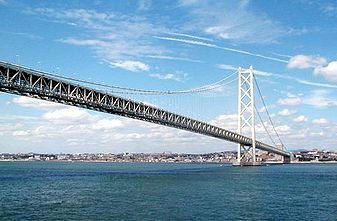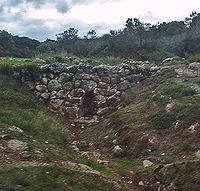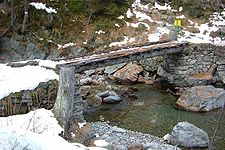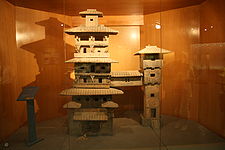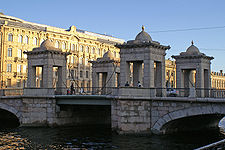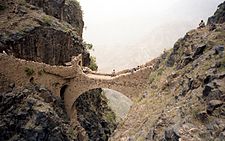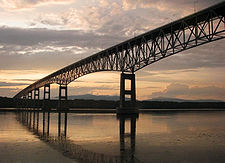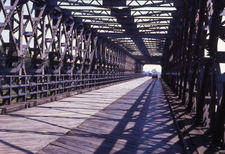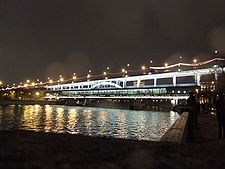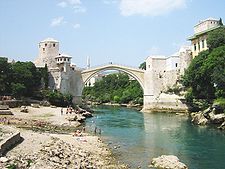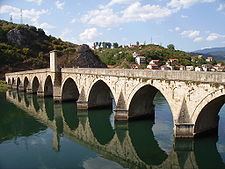- Bridge
-
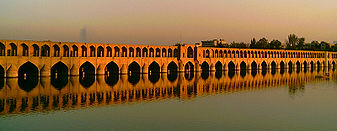 The Si-o-se Pol bridge over Zayandeh River is the epitome of Safavid dynasty (1502–1722) bridge design. Esfahan, Iran
The Si-o-se Pol bridge over Zayandeh River is the epitome of Safavid dynasty (1502–1722) bridge design. Esfahan, Iran
A bridge is a structure built to span physical obstacles such as a body of water, valley, or road, for the purpose of providing passage over the obstacle. Designs of bridges vary depending on the function of the bridge, the nature of the terrain where the bridge is constructed, the material used to make it and the funds available to build it.
Contents
Etymology
The Oxford English Dictionary traces the origin of the word bridge to an Old English word brycg, of the same meaning, derived from a hypothetical Proto-Germanic root brugjō. There are cognates in other Germanic languages.
History
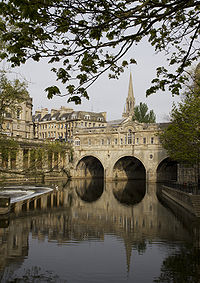 An English 18th century example of a bridge in the Palladian style, with shops on the span: Pulteney Bridge, Bath
An English 18th century example of a bridge in the Palladian style, with shops on the span: Pulteney Bridge, Bath A Han Dynasty (202 BC – 220 AD) Chinese miniature model of two residential towers joined by a bridge
A Han Dynasty (202 BC – 220 AD) Chinese miniature model of two residential towers joined by a bridge
The first bridges were made by nature itself — as simple as a log fallen across a stream or stones in the river. The first bridges made by humans were probably spans of cut wooden logs or planks and eventually stones, using a simple support and crossbeam arrangement. Some early Americans used trees or bamboo poles to cross small caverns or wells to get from one place to another. A common form of lashing sticks, logs, and deciduous branches together involved the use of long reeds or other harvested fibers woven together to form a connective rope capable of binding and holding together the materials used in early bridges.
The Arkadiko Bridge is one of four Mycenaean corbel arch bridges part of a former network of roads, designed to accommodate chariots, between Tiryns to Epidauros in the Peloponnese, in Greece. Dating to the Greek Bronze Age (13th century BC), it is one of the oldest arch bridges still in existence and use. Several intact arched stone bridges from the Hellenistic era can be found in the Peloponnese in southern Greece[2]
The greatest bridge builders of antiquity were the ancient Romans.[3] The Romans built arch bridges and aqueducts that could stand in conditions that would damage or destroy earlier designs. Some stand today.[4] An example is the Alcántara Bridge, built over the river Tagus, in Spain. The Romans also used cement, which reduced the variation of strength found in natural stone.[5] One type of cement, called pozzolana, consisted of water, lime, sand, and volcanic rock. Brick and mortar bridges were built after the Roman era, as the technology for cement was lost then later rediscovered.
The Arthashastra of Kautilya mentions the construction of dams and bridges.[6] A Mauryan bridge near Girnar was surveyed by James Princep.[7] The bridge was swept away during a flood, and later repaired by Puspagupta, the chief architect of emperor Chandragupta I.[7] The bridge also fell under the care of the Yavana Tushaspa, and the Satrap Rudra Daman.[7] The use of stronger bridges using plaited bamboo and iron chain was visible in India by about the 4th century.[8] A number of bridges, both for military and commercial purposes, were constructed by the Mughal administration in India.[9]
Although large Chinese bridges of wooden construction existed at the time of the Warring States, the oldest surviving stone bridge in China is the Zhaozhou Bridge, built from 595 to 605 AD during the Sui Dynasty. This bridge is also historically significant as it is the world's oldest open-spandrel stone segmental arch bridge. European segmental arch bridges date back to at least the Alconétar Bridge (approximately 2nd century AD), while the enormous Roman era Trajan's Bridge (105 AD) featured open-spandrel segmental arches in wooden construction.
Rope bridges, a simple type of suspension bridge, were used by the Inca civilization in the Andes mountains of South America, just prior to European colonization in the 16th century.
During the 18th century there were many innovations in the design of timber bridges by Hans Ulrich, Johannes Grubenmann, and others. The first book on bridge engineering was written by Hubert Gautier in 1716. A major breakthrough in bridge technology came with the erection of the Iron Bridge in Coalbrookdale, England in 1779. It used cast iron for the first time as arches to cross the river Severn.
With the Industrial Revolution in the 19th century, truss systems of wrought iron were developed for larger bridges, but iron did not have the tensile strength to support large loads. With the advent of steel, which has a high tensile strength, much larger bridges were built, many using the ideas of Gustave Eiffel.
In 1927 welding pioneer Stefan Bryła designed the first welded road bridge in the world, which was later built across the river Słudwia Maurzyce near Łowicz, Poland in 1929. In 1995, the American Welding Society presented the Historic Welded Structure Award for the bridge to Poland.[10]
Types of bridges
There are six main types of bridges: beam bridges, cantilever bridges, arch bridges, suspension bridges, cable-stayed bridges and truss bridges.
Beam bridges
Beam bridges are horizontal beams supported at each end by abutments, hence their structural name of simply supported. When there is more than one span the intermediate supports are known as piers. The earliest beam bridges were simple logs that sat across streams and similar simple structures. In modern times, beam bridges are large box steel girder bridges. Weight on top of the beam pushes straight down on the abutments at either end of the bridge.[11] They are made up mostly of wood or metal. Beam bridge spans typically do not exceed 250 feet (76 m) long, as the strength of a span decreases with increased length. However, the main span of the Rio-Niteroi Bridge, a box girder bridge, is 300 metres (980 ft). The world's longest beam bridge is Lake Pontchartrain Causeway in southern Louisiana in the United States, at 23.83 miles (38.35 km), with individual spans of 56 feet (17 m).Cite error: Closing
</ref>missing for<ref>tag; see the help pageTied arch bridges
Tied arch bridges have an arch-shaped superstructure, but differ from conventional arch bridges. Instead of transferring the weight of the bridge and traffic loads into thrust forces into the abutments, the ends of the arches are restrained by tension in the bottom chord of the structure. They are also called bowstring arches.
Suspension bridges
Suspension bridges are suspended from cables. The earliest suspension bridges were made of ropes or vines covered with pieces of bamboo. In modern bridges, the cables hang from towers that are attached to caissons or cofferdams. The caissons or cofferdams are implanted deep into the floor of a lake or river. The longest suspension bridge in the world is the 12,826 feet (3,909 m) Akashi Kaikyo Bridge in Japan.[12] See simple suspension bridge, stressed ribbon bridge, underspanned suspension bridge, suspended-deck suspension bridge, and self-anchored suspension bridge.
Cable-stayed bridges
Cable-stayed bridges, like suspension bridges, are held up by cables. However, in a cable-stayed bridge, less cable is required and the towers holding the cables are proportionately shorter.[13] The first known cable-stayed bridge was designed in 1784 by C.T. Loescher.[14] The longest cable-stayed bridge is the Sutong Bridge over the Yangtze River in China.
Movable bridges
Movable bridges are designed to move out of the way of boats or other kinds of traffic, which would otherwise be too tall to fit. These are generally electrically powered.
Double-decked bridges
Double-decked or double-decker bridges have two levels, such as the San Francisco – Oakland Bay Bridge, with two road levels. Tsing Ma Bridge and Kap Shui Mun Bridge in Hong Kong have six lanes on their upper decks, and on their lower decks there are two lanes and a pair of tracks for MTR metro trains. Some double-decker bridges only use one level for street traffic; the Washington Avenue Bridge in Minneapolis reserves its lower level for automobile traffic and its upper level for pedestrian and bicycle traffic (predominantly students at the University of Minnesota). Likewise, in Toronto, the Prince Edward Viaduct has five lanes of motor traffic, bicycle lanes, and sidewalks on its upper deck; and a pair of tracks for the Bloor–Danforth subway line.
Robert Stephenson's High Level Bridge across the River Tyne in Newcastle upon Tyne, completed in 1849, is an early example of a double-deck bridge. The upper level carries a railway, and the lower level is used for road traffic. Other examples include Britannia Bridge over the Menai Strait and Craigavon Bridge in Derry, Northern Ireland. The Oresund Bridge between Copenhagen and Malmö consists of a four-lane highway on the upper level and a pair of railway tracks at the lower level.
The George Washington Bridge between New Jersey and New York has two roadway levels. It was built with only the upper roadway as traffic demands did not require more capacity. A truss work between the roadway levels provides stiffness to the roadways and reduced movement of the upper level when installed. Tower Bridge is different example of a double-decker bridge, with the central section consisting of a low level bascule span and a high level footbridge.
Old Yamuna Bridge (Delhi) or Bridge No. 249 in technical railway parlance, was constructed in 1866 by the East India Railway at a cost of £16,16,335. It was built with a total length of 2,640 feet (800 m) and consisted of 12 spans of 202.5 feet (61.7 m) each. With the completion of this bridge, two principal cities of North India, Kolkata and Delhi, were connected by the railways; this being the last link of the trunk line on this route. In 1913, this was converted into a double line by adding down line girders of 12 spans of 202 feet (62 m) each and 2 end spans of 42 feet (13 m) to the bridge. For the movement of road traffic, two road bridges were provided below the lines. The entry of trains into Delhi Junction Railway station, in such close proximity to the Red Fort, never ceases to impress the rail traveler,[citation needed] reminding all that after the Uprising of 1857, Delhi was a fortified city. The old Yamuna Bridge has an identical twin, a bridge further downstream at Naini on the Allahabad — Mughalsarai section of the now North Central Railways.
By use
A bridge is designed for trains, pedestrian or road traffic, a pipeline or waterway for water transport or barge traffic. An aqueduct is a bridge that carries water, resembling a viaduct, which is a bridge that connects points of equal height. A road-rail bridge carries both road and rail traffic.
Bridges are subject to unplanned uses as well. The areas underneath some bridges have become makeshift shelters and homes to homeless people, and the undersides of bridges all around the world are spots of prevalent graffiti. Some bridges attract people attempting suicide, and become known as suicide bridges.
To create a beautiful image, some bridges are built much taller than necessary. This type, often found in east-Asian style gardens, is called a Moon bridge, evoking a rising full moon. Other garden bridges may cross only a dry bed of stream washed pebbles, intended only to convey an impression of a stream. Often in palaces a bridge will be built over an artificial waterway as symbolic of a passage to an important place or state of mind. A set of five bridges cross a sinuous waterway in an important courtyard of the Forbidden City in Beijing, China. The central bridge was reserved exclusively for the use of the Emperor, Empress, and their attendants.
Structure
Bridges may be classified by how the forces of tension, compression, bending, torsion and shear are distributed through their structure. Most bridges will employ all of the principal forces to some degree, but only a few will predominate. The separation of forces may be quite clear. In a suspension or cable-stayed span, the elements in tension are distinct in shape and placement. In other cases the forces may be distributed among a large number of members, as in a truss, or not clearly discernible to a casual observer as in a box beam. Bridges can also be classified by their lineage, which is shown as the vertical axis on the diagram.[clarification needed]
Efficiency
A bridge's structural efficiency is the ratio of load carried to bridge mass, given a specific set of material types. In one common challenge students are divided into groups and given a quantity of wood sticks, a distance to span, and glue, and then asked to construct a bridge that will be tested to destruction by the progressive addition of load at the center of the span. The bridge taking the greatest load is by this test the most structurally efficient. A more refined measure for this exercise is to weigh the completed bridge rather than measure against a fixed quantity of materials provided and determine the multiple of this weight that the bridge can carry, a test that emphasizes economy of materials and efficient glue joints (see balsa wood bridge).
A bridge's economic efficiency will be site and traffic dependent, the ratio of savings by having a bridge (instead of, for example, a ferry, or a longer road route) compared to its cost. The lifetime cost is composed of materials, labor, machinery, engineering, cost of money, insurance, maintenance, refurbishment, and ultimately, demolition and associated disposal, recycling, and replacement, less the value of scrap and reuse of components. Bridges employing only compression are relatively inefficient structurally, but may be highly cost efficient where suitable materials are available near the site and the cost of labor is low. For medium spans, trusses or box beams are usually most economical, while in some cases, the appearance of the bridge may be more important than its cost efficiency. The longest spans usually require suspension bridges.
Other functions
Some bridges accommodate other purposes, such as the tower of Nový Most bridge in Bratislava, which features a restaurant. Other suspension bridge towers carry transmission antennas.
A bridge can carry overhead power lines as does the Storstrøm Bridge.
Costs and cost overruns frequently occur in bridge construction. Flyvbjerg et al. (2003) found the average cost overrun in bridge building is 34%.[15]
In railway parlance, an overbridge is a bridge crossing over the course of the railway. In contrast, an underbridge allows passage under the line.
Bridge failures
See also: List of bridge failuresThe failure of bridges is of special concern for structural engineers in trying to learn lessons vital to bridge design, construction and maintenance. The failure of bridges first assumed national interest during the Victorian era when many new designs were being built, often using new materials.
In the United States, the National Bridge Inventory tracks the structural evaluations of all bridges, including designation as "structurally deficient" and "functionally obsolete".
Visual index
See also: List of bridge typesSee also
- Architectural structure
- Bridge to Nowhere (disambiguation)
- Cost overrun in bridge construction
- Footbridge
- Landscape architecture
- Megaproject
- Overpass
- Oxford BT Centre for Major Programme Management
- Sea bridge
- BS 5400, a British Standard for steel, concrete and composite bridges
- contrast with tunnel
References
- Notes
- ^ Roman Bridge in Cordoba ( 1st century B.C.)
- ^ T.H. Nielsen and J. Roy. Defining ancient Arkadia: symposium April 1–4, 1998. Kgl. Danske Videnskabernes Selska, 1998. p. 253. [1]
- ^ Context for World Heritage Bridges
- ^ History of BRIDGES
- ^ Lessons from Roman Cement and Concrete
- ^ Dikshitar, pg. 332
- ^ a b c Dutt, pg 46
- ^ "suspension bridge" in Encyclopaedia Britannica (2008). 2008 Encyclopedia Britannica, Inc.
- ^ Nath, pg. 213
- ^ Sapp, Mark E. (February 22, 2008). "Welding Timeline 1900-1950". WeldingHistory.org. http://www.weldinghistory.org/whistoryfolder/welding/wh_1900-1950.html. Retrieved 2008-04-29.
- ^ "Beam bridges". Design Technology. http://www.design-technology.org/beambridges.htm. Retrieved 2008-05-14.
- ^ Sigmund, Pete (2007-02-07). "The Mighty Mac: A Sublime Engineering Feat". Construction Equipment Guide. http://www.constructionequipmentguide.com/story.asp?story=8153&headline=The%20Mighty%20Mac:%20A%20Sublime%20Engineering%20Feat. Retrieved 2008-05-14.
- ^ Johnson, Andy. "Cable Stay vs Suspension Bridges". U.S. Department of Energy. http://www.newton.dep.anl.gov/askasci/eng99/eng99373.htm.
- ^ "Bridges". NYCDOT. http://www.nyc.gov/html/dot/html/bridges/bridges.shtml. Retrieved 2008-05-14.
- ^ Flyvbjerg, Bent, Nils Bruzelius, and Werner Rothengatter, 2003. Megaprojects and Risk: An Anatomy of Ambition (Cambridge: Cambridge University Press).
- Bibliography
- Brown, David J. Bridges: Three Thousand Years of Defying Nature. Richmond Hill, Ont: Firefly Books, 2005. ISBN 1-55407-099-6.
- Sandak, Cass R. Bridges. An Easy-read modern wonders book. New York: F. Watts, 1983. ISBN 0-531-04624-9.
- Whitney, Charles S. Bridges of the World: Their Design and Construction. Mineola, NY: Dover Publications, 2003. ISBN 0-486-42995-4 (Unabridged republication of Bridges : a study in their art, science, and evolution. 1929.)
- Dikshitar, V. R. R. Dikshitar (1993). The Mauryan Polity. Motilal Banarsidass. ISBN 81-208-1023-6.
- Dutt, Romesh Chunder (2000). A History of Civilisation in Ancient India: Vol II. Routledge. ISBN 0-415-23188-4.
- Nath, R. (1982). History of Mughal Architecture. Abhinav Publications. ISBN 81-7017-159-8.
- Kinney, A. R.; el al. (2003). Worshiping Siva and Buddha: The Temple Art of East Java. University of Hawaii Press. ISBN 0-8248-2779-1.
- Buck, William; el al. (2000). Ramayana. University of California Press. ISBN 0-520-22703-4
External links
- Digital Bridge: Bridges of the Nineteenth Century, a collection of digitized books at Lehigh University
- Structurae - International Database and Gallery of Engineerings Structures with over 10000 Bridges.
- U.S. Federal Highway Administration Bridge Technology
- Bridge enthusiast site
- Video on how bridges are made (Grade school level educational film by National Association of Manufactures.)
- The Museum of Japanese Timber Bridges Fukuoka University
- "en.Broer.no": site for bridges
- [2] (CNN) 24 of the World's Most Amazing Bridges -retrieved 30 Apr 2011
- Amazing footage of strangler figs made into "living bridges." [3]
Bridge-related articles Types of bridges Moveable bridge · Beam bridge · Cantilever bridge · Arch bridge · Suspension bridge · Cable-stayed bridge · Truss bridge · Visual index to various typesLists of bridges List of bridges · By length · Longest suspension bridge spans · Largest cable-stayed bridges · Longest cantilever bridges · Longest continuous truss bridges · Arch bridges · Highest · Tallest · Bridge failuresCategories:
Wikimedia Foundation. 2010.

